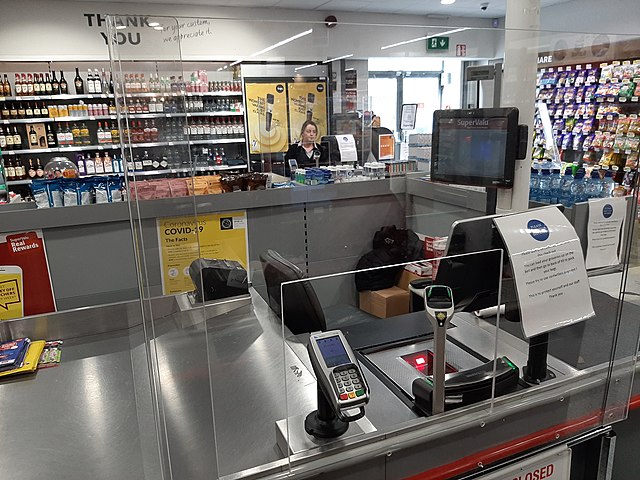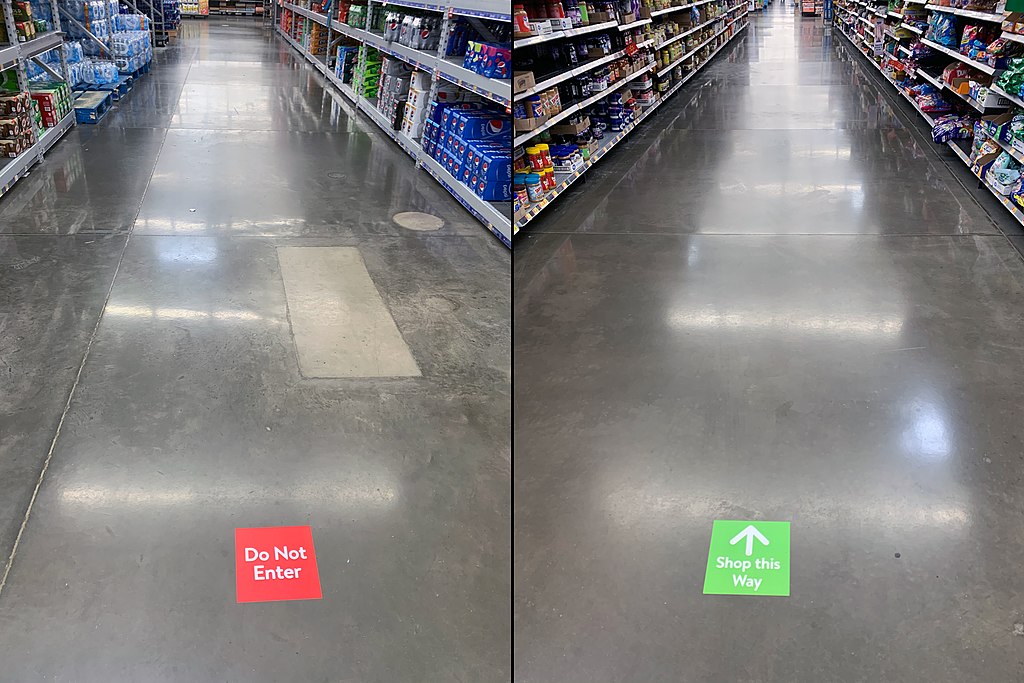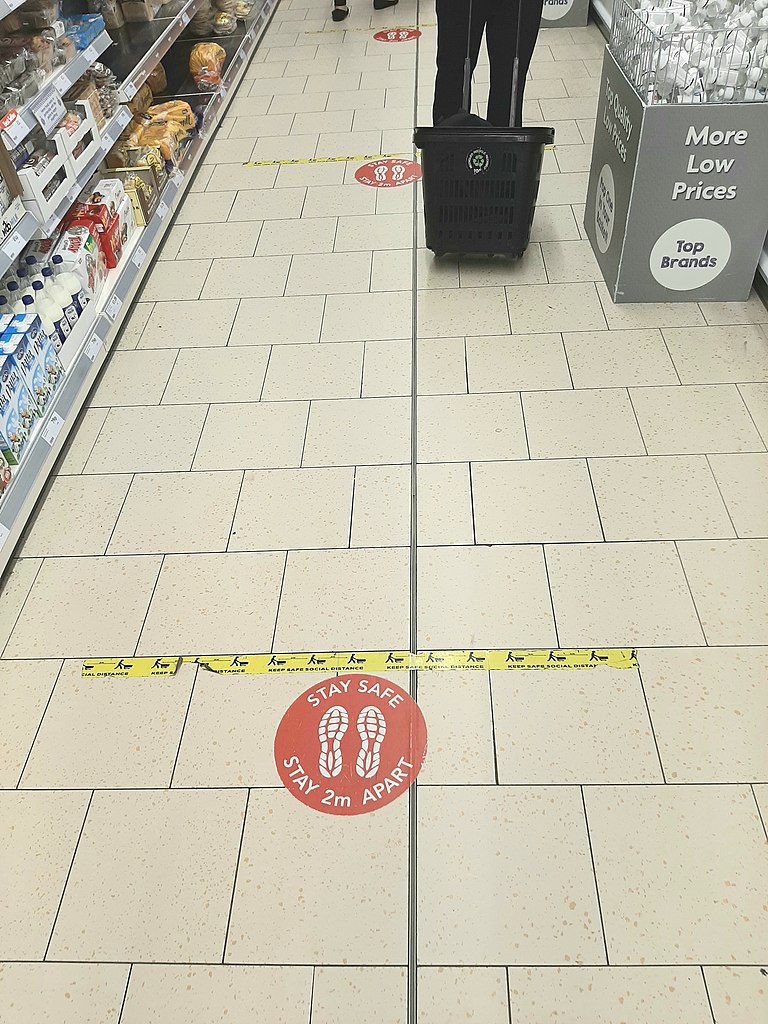2 Coronavirus vs. Grocery Stores
Hannah Wilson
Introduction
COVID-19 has brought about great change to the daily routines and lives of Americans. From major things, such as losing jobs, to smaller things, like eating at home instead of going to restaurants, American society has seen great change within their communities. A major part of every community is the local grocery store, and the Coronavirus pandemic has greatly disrupted people’s time at the grocery store. To remain open, the way grocery stores looked and functioned had to change to keep both customers and workers safe. Due to the COVID-19 pandemic, grocery stores adapted to changes using different forms of technology and social distancing regulations. These different safety measures benefit both the customer and grocery store employees, which included having the option to buy groceries online and picking them up instead of going in the store and new technology that allowed for less person to person contact within the store. With the regulations and new technology used, some people had different opinions on the way things were conducted.
Connection to STS Theory
Regulations and technology implemented by grocery stories strongly relate to the Actor Network Theory in the Science and Technology in Society curriculum. This theory states that anything that occurs in the world is the result of interactions between many different factors (actors), which can be human or non-human ones. The three main actors present are grocery stores, customers, and the Coronavirus. What each actor does impacts the outcomes of the Coronavirus pandemic and situations in grocery stores, since all the actors are interconnected. For example, if there were no regulations placed in grocery stores, then more customers and employees would get sick from COVID-19, thus raising Coronavirus transmission rates overall. If the regulations we know to work today were implemented earlier in grocery stores, then there is a possibility that less people would have contracted the disease.
Grocery Store Regulations
To keep grocery stores open, many regulations were put in place to ensure the safety of customers and workers. Some regulations that were put in place were specific to grocery stores and possibly used in clothing stores as well. A major regulation that can be seen throughout most if not all grocery stores across America is the use of plexiglass. This is a thin piece of plastic that is placed between the cashier and the customer at the checkout lane (Figure 1). It is used since there is no possible way to put six feet, which is the Centers for Disease Control and Prevention (CDC)’s guideline for social distancing between other people to limit transmission, between the grocery store employee and customers. The plexiglass limits the spread of the coronavirus by literally acting as a shield to block and stop any particles possibly coming from one’s mouth to the other person. The use of plexiglass is one way that grocery stores have tried to limit the spread of COVID-19 (Ngowi).

Another major regulation used in grocery stores during the COVID-19 pandemic includes the use of stickers on the floor throughout the store. These stickers are used as directional signs to limit the amount of people near one another. They include social distancing stickers that are used primarily in checkout lines to ensure that customers are waiting in line six feet apart (Figure 2).

Most people cannot tell how long six feet is so the stickers that are placed on the floor deletes the guessing game. The other sticker that is commonly used in grocery stores are the one-way aisle stickers. These stickers are like one-way street signs that are seen while driving on a one-way road. Customers are only supposed to enter and exit from one direction. This is used to limit people walking by others in hopes of decreasing the amount of person to person contact one has while in the store (Redman) (Figure 3).

Specific stores have provided more regulations that may or may not appear in other grocery stores across the United States. Walmart is an example of a store that has put many precautions and regulations for the safety of both customers and the employees in place, including the ones previously mentioned. Like most grocery stores and many other places of business, masks are required for both the customer and the employee to be in the store. Masks have been proven to lower the rate of possible transmission, so that is why they are required at Walmart and many other stores. Also, “enhanced cleaning routines” were put in place, which includes but is not limited to sanitizing the carts between each customer’s use (Walmart). To limit person to person contact, separate entrances and exits has been used in some Walmart locations while others have barriers telling which side is an entrance and which is an exit. This limits customers to be able to walk in and out of whatever door they please. Lastly, Walmart has provided an extra hour of possible shopping to anyone over the age of sixty. Because this age is said to be the most vulnerable, the fewer people that are present in the store provides a better chance for those older customers to not contract the disease (Walmart).
For guidance on what guidelines stores, like Walmart, should implement, studies have been conducted to figure out what works best. A study by Hernandez-Mejia and Hernandez-Vargas showed that certain guidelines need to be put in place to limit the spread of COVID-19. The two regulations studied were social distancing guidelines and the amount of people that can be in the store at one time. They set up a fake grocery store and had certain restrictions on the movement of the customers based on which regulation they were studying at the time and would change for different specifications of a regulation; for example, they studied social distancing at lengths that varied from 30 cm to 2 m. Hernandez-Mejia and Hernandez-Vargas concluded that social distancing of at least 1.5 m and limiting the amount of people in the store, which is based on the size of the store, is necessary for the safety of customers and employees (1-7).
New Changes
Even though regulations were implemented in grocery stores to make shopping a safer place, there are some people who prefer to shop for their groceries in a different way. According to a study by Grashius, the amount of positive COVID-19 cases plays a role in how people shop for their groceries. When the rate of Coronavirus cases is low in a community, that community is more likely to go into a store and shop for their groceries like they normally would. However, if Coronavirus cases are high or begin to rise quickly, then people are more likely to find alternative ways to shop for their groceries. There is another major reason that can influence one’s decision of going into a grocery store to shop or use an alternative method. That reason could be that family or friends have a compromised immune system, so it would be dangerous for them to possibly expose themselves to the virus even though regulations have reduced the risk. The alternative methods include the use of curbside pickup and shopping for groceries online and have the groceries delivered to one’s house, which limits person to person contact (Grashius).
New technology has arisen that has made it easier for customers to get their groceries safely. One of those that was already in use at some stores but has become more popular is curbside pickup. This limits person to person contact by pre-ordering groceries and going to the grocery store to pick up the groceries without having to leave the car. Another one that was in the works before the pandemic for some stores like Walmart is the use of an app that is personalized to that grocery store. The app allows customers to scan their own groceries throughout their shopping trip and be billed through the app instead of going through a checkout line. The use of the app also allows for less person to person contact when compared to a normal grocery trip that ends with being in a long checkout line near others. Other stores have used a different type of technology that allows customers to skip the checkout line. A new type of grocery cart is used in some stores that can automatically scan what is being put into the cart and delete the items from the bill that are taken out of the cart. When going to a store that has these carts, a customer must first scan a QR code that connects the cart to the customer that is going to be billed. After that, the customer can shop like normal, and when they are done, the customer scans the QR code on the way out to disconnect the cart from their bill. He or she will then be billed for their groceries without having to wait in a checkout line (Palmer and Repko).
Even with new technology and many regulations for the safety of the customer, some still do not want to go into a grocery store, so they have turned to online grocery shopping to get their groceries. This service works similarly to how one orders clothes online and is shipped to their house. This seems to be the most convenient option since it takes little time and puts the person to person contact at zero unless the customer talks to the person who is delivering the food. Amazon was already using online grocery shopping but other big grocery stores like Walmart and Target have joined the competition and outperform Amazon in online grocery shopping. This is probably because people who switched to online grocery shopping instead of going into the store may have shopped at Walmart or Target beforehand and wanted to continue shopping at those companies (Juntti).
Society’s Personal Views
Throughout this pandemic, there have been some varying views on what to do. This can include the risk to grocery store workers since they believe they are not getting the treatment they deserve. Many grocery store workers want safer work conditions that help them since most regulations can be seen to be geared more towards the customer. Many just want more cleaning supplies to keep their area clean but most employees do not receive them at some stores across varying brands. Most grocery store workers want higher pay since they are working under an extreme condition where they could contract a deadly disease. No one knows what the right amount of payment and supplies these workers need to be safe but most just want clarification on who has been sick around them so they can take personal action accordingly (Lucky 6).
With the struggle of protecting grocery store workers and making the job still appealing to new and future employees, there are some customers who have made that task even harder. Some people do not believe in the effectiveness of masks, and some people believe there could be a political basis in this. When asked, people who did not wear masks said they do so because there is no real and helpful use for masks, they want to breath better, and that some were persuaded by political tactics into wearing one. Even though some people believe masks are not useful, the CDC has said otherwise so most grocery stores require their customers to wear masks properly to be able to enter the store (“Why Some Americans Won’t Wear Face Masks…”).
Conclusion
The Coronavirus has caused many businesses to change what they do and implement new regulations so the stores can stay open and safely serve their customers. Many regulations were put in place in grocery stores to make them safer places for both customers and workers. Some of those regulations include wearing masks, social distancing and one-way aisle stickers, plexiglass between customers and workers when checking out, and some new technological advances. Even with these regulations, online shopping has become the best option for some and is continuing to become a bigger market. There has been some controversy over what grocery store workers should be getting because of their hard work and high risk, and wearing masks became debatable since some believed the masks were of no help. This shows a strong connection to the Actor Network Theory since all of the factors that have gone into limiting the spread of the coronavirus are connected.
References
Grashius, Jasper, et al. “Grocery Shopping Preferences during the COVID-19 Pandemic.” Sustainability, vol. 12, no. 13, 2020, https://doi.org/10.3390/su12135369.
Hernandez-Mejia, Gustavo, and Esteban A. Hernandez-Vargas. “When Is SARS-CoV-2 in Your Shopping List?” Mathematical Biosciences, vol. 328, Oct. 2020 pp. 1-7. https://doi.org/10.1101/2020.06.11.20128850
Juntti, Melaina. “How COVID-19 Has Changed Online Grocery Shopping for Good.” New Hope Network, 21 May 2020, www.newhope.com/market-data-and-analysis/how-covid-19-has-changed-online-grocery-shopping-good.
Lucky, Katherine. “COVID-19 and the Food Supply.” Commonweal, vol. 147, no. 5, May 2020, pp. 6. http://libproxy.clemson.edu/login?url=http://search.ebscohost.com/login.aspx?direct=true&db=a9h&AN=142901012.
Ngowi, Rodrique. “What’s in Store: Groceries Installing Barriers amid Outbreak.” ABC News, 26 Mar. 2020, abcnews.go.com/Health/wireStory/store-groceries-installing-barriers-amid-outbreak-69818118.
Palmer, Annie, and Melissa Repko. “How the Coronavirus Pandemic Helped Convince Grocery Chains to Experiment with New Tech.” CNBC, 6 Sept. 2020, www.cnbc.com/2020/09/06/how-coronavirus-convinced-grocery-chains-to-experiment-with-new-tech-.html.
Redman, Russell. “UPDATE: Walmart, Kroger, Hy-Vee, Giant Go with One-Way Aisles to Combat Coronavirus.” Supermarket News, 7 Apr. 2020, www.supermarketnews.com/issues-trends/update-walmart-kroger-hy-vee-giant-go-one-way-aisles-combat-coronavirus.
Walmart. “Important Store Info.” Corporate, 24 Sept. 2020, corporate.walmart.com/important-store-info.
“Why Some Americans Won’t Wear Face Masks, in Their Own Words.” Advisory Board Daily Briefing, 19 June 2020, www.advisory.com/daily-briefing/2020/06/19/mask-wearing.
Images
“Ersatz protection for employees deployed in a grocery store during the 2020 coronavirus pandemic” by Auguste Blanqui is licensed under CC BY-SA 4.0
“One way aisles for social distancing at Walmart” by Saucy is licensed under CC BY-SA 4.0
“Socially Distanced Shopping” by Zakhx150 is licensed under CC BY 4.0

